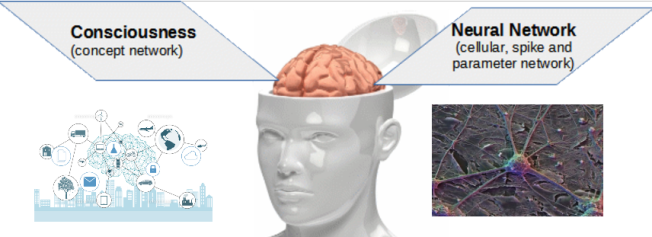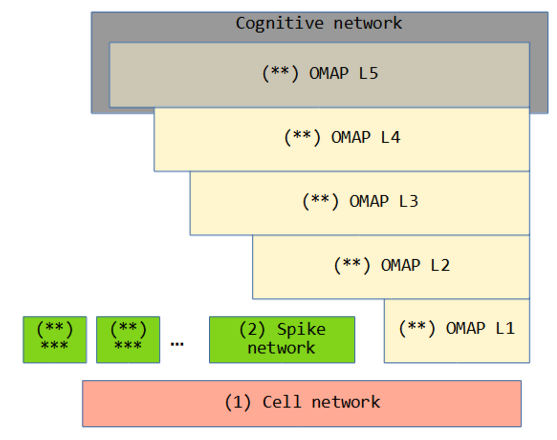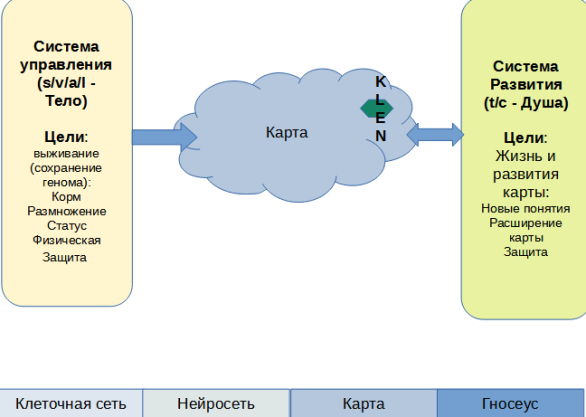GTOM: Difference between revisions
No edit summary |
|||
| Line 48: | Line 48: | ||
The adaptive capabilities of an organism are ensured by creating an object map of the habitat (OMAP). The map includes objects present in the territory and the relationships between these objects. The object map OMAP is a replica of the tangible world and is placed in specialized nervous tissue. The motor activity of the organism is significantly modified based on the OMAP. | The adaptive capabilities of an organism are ensured by creating an object map of the habitat (OMAP). The map includes objects present in the territory and the relationships between these objects. The object map OMAP is a replica of the tangible world and is placed in specialized nervous tissue. The motor activity of the organism is significantly modified based on the OMAP. | ||
===== Stages of OMAP | ===== Stages of OMAP Evolution ===== | ||
<div>[[File:OMAP_evolution.png|alt=OMAP Evolution|center]] | <div>[[File:OMAP_evolution.png|alt=OMAP Evolution|center]] | ||
</div>At the beginning of the evolution of the OMAP map, all objects on the map had to be defined at the moment of the organism's birth as classes. The presence of sensory systems is not strictly necessary for creating new classes but is only used for distinguishing known classes and creating objects of these classes as part of the OMAP. | </div>At the beginning of the evolution of the OMAP map, all objects on the map had to be defined at the moment of the organism's birth as classes. The presence of sensory systems is not strictly necessary for creating new classes but is only used for distinguishing known classes and creating objects of these classes as part of the OMAP. | ||
Revision as of 00:44, 2 December 2024
Purpose of the Theory
Gativus Theory Of Mind presents a technical theory of consciousness development in high-level organisms, consisting of sequential hypotheses (Hypothesis OMAP, etc.).
Definition of Consciousness
Consciousness is a process occurring in the cognitive network of high-level organisms, explicitly enhancing the processes aimed at achieving the genetic goal of "survival," as well as providing more effective adaptation to a changing environment compared to those without a cognitive network.
1. Hypothesis of "Ownership"
Consciousness is not the property of a single organism but simultaneously relates to the Environment, the Goal, and the Organism.
2. Hypothesis OMAP
The basis of human consciousness is the OMAP-1 map. It was created for entirely different purposes but later evolved into OMAP-5, which is the cognitive network that constitutes consciousness.
Consequence
By accepting these hypotheses, one can "visualize" thought and consciousness as a whole. In particular:
(a) expansion of the cognitive network ("seeing");
(b) visualization of the movement route (task setting);
(c) actual execution of the visualized goal.
Problem of "Connection of Two Networks"
From the definition of consciousness, it is unclear how it is connected to the cellular network.
By accepting the fact that consciousness simultaneously exists as two networks and that they converge with each other, one leads to the other, we approach consciousness from two sides.
1) Gativus Low Level Network – GLLN
Based on the understanding of the cellular and spiking networks.
Structure-Value-Activity
2) Gativus Cognitive Network – GCON
Based on the understanding of RDF / Class Diagram. The hypothesis that the cognitive network consists of a sequence of advanced knowledge entities “knowledge entity - KLEN”, reflecting actions, and the objects used in those actions. KLEN consists of actions (T - Targets), and the objects of these actions are "concepts" (C – Concepts).
Convergence of Two Networks, Thanks to Hypothesis OMAP
Definition of OMAP
The adaptive capabilities of an organism are ensured by creating an object map of the habitat (OMAP). The map includes objects present in the territory and the relationships between these objects. The object map OMAP is a replica of the tangible world and is placed in specialized nervous tissue. The motor activity of the organism is significantly modified based on the OMAP.
Stages of OMAP Evolution
At the beginning of the evolution of the OMAP map, all objects on the map had to be defined at the moment of the organism's birth as classes. The presence of sensory systems is not strictly necessary for creating new classes but is only used for distinguishing known classes and creating objects of these classes as part of the OMAP.
| Stage | Features | Components |
| OMAP-1 | A distinctive feature of this stage of evolution is the binding of all L – objects to the root/initial one, which is the first territory perceived by the organism.
The presence of the OMAP map allows the organism to calculate the movement route and execute it at the maximum possible speed. |
Objects on such a map are L – components, and their relationships are L - relationships.
The route is represented as a T – component and can be composite TCOM. In this case, T- relationships of the sequence are established. |
| ... | ... | ... |
| OMAP-5 | Abstract aggregation of concepts, L – components ultimately become the basis for C - components |
Consequence of the Hypothesis
A highly organized organism forms a technical space (neocortex) for creating a developed network of abstract aggregation OMAP-5 within it.
The created OMAP-5, in essence, is a separate organism with its own goals and tasks. However, it enriches its predecessor (the old brain and its organs) with new capabilities.
The human "I" represents the result of the work of the OMAP-5 network, which arose from the OMAP-1 map and is technically located within its space.



